Introduction:
Walls and roofs have been the primary and most fundamental needs of human dwellings ever since the concept of a house was first conceived. Bricks replaced stones as the preferred material for construction. We used a lot of water to make mortar and let it cure, but that’s no longer necessary thanks to cement; thus, stone and brick masonry is becoming increasingly obsolete. A drywall is a type of wall that is not made of bricks or plaster; both need water in some way. As the world’s water supply dwindles, this is crucial in ensuring that future generations can continue to benefit from our current resources.
The Drywall System was developed by the U.S. Gypsum Company (USG) in 1916. The Sackett plaster firm, a division of USG, is responsible for the product’s original name, “Sackett Board.” Small fireproof tiles were offered for sale, but subsequent years saw the product reformulate into multilayer sheets of gypsum and paper. In fewer than ten years, it evolved into its present form, with compressed gypsum between two thick sheets of paper.
What is Drywall?
Drywall, also known as gypsum board, is typically used to finish off the insides of buildings. Drywall is commonly referred to by various names, including gypsum panel, sheetrock, wallboard, custard board, buster board, etc.
The drywall consists of a gypsum board in between two paper boards. The gypsum plaster used to adhere to them hardens quickly. To the gypsum plaster, other chemicals like foaming agents and plasticizers are sometimes added. Drywall was first used in the construction industry in the United States during the twentieth century to save the time and money spent on plastering.
Construction of Drywall:
Drywalling a full house takes only a few days for two professionals. It reduces the amount of time needed to plaster a wall. This wall-covering option is practical and affordable as a substitute for traditional brick or stone. Drywall panels are easy enough to put up that many do-it-yourself home handymen can do it. The Hangers and the Mud-man are specialists in their field, but they work together to complete the drywall installation process. A drywall panel hanger secures the boards and panels to the wall using screws and nails, and a drywall compound, “mud-man,” fill the seams between the panels.
Installation Process of Drywall:
- The first step is to take precise measurements of the area that will host the drywall. Take precise measurements of the room’s dimensions.
- Second, draw a complete map of the area, including all known elevations.
- Placing the drywall is the next step. The white marking sign, which must be affixed to the drywall’s upper surface, requires our attention. If you need to mark a straight line, use a scale.
- Use a utility knife for scoring, but don’t use too much pressure since doing so can lead the blade to penetrate deeper and cross the hard-line, resulting in extra complications.
- It will cut in half at the point of impact and leave a noticeable bump in the rear sight after being scored.
- The drywall’s backing paper will need to be cut using a utility knife.
- We must take it there and put it to the test immediately.
- Use screws for fitting after careful testing; otherwise, improper spacing and intervals will lead to many issues.
- Don’t risk drywall damage by skimping on the screws; instead, use many.
Types of Drywall:
1. Regular Drywall:
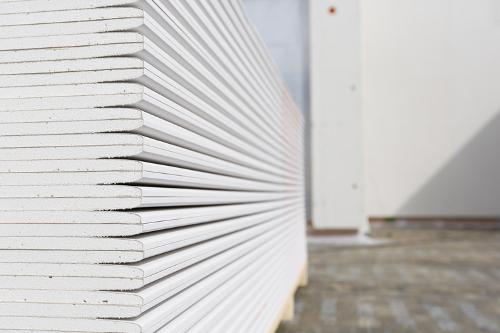
Fig1: Regular Drywall
Courtesy: tejasmaterials.com
Most ceilings and walls in homes and businesses are made of regular drywall, also called “whiteboard.” Half an inch is the most common thickness for homes. The most common drywall sheet size is 4′ x 8′, but it can also come in lengths of up to 16′ for rooms with high ceilings. Home improvement stores sell drywall sheets that are 2′ x 2′, so they are easier to carry and can be used for small repairs.
2. Soundproof Drywall:
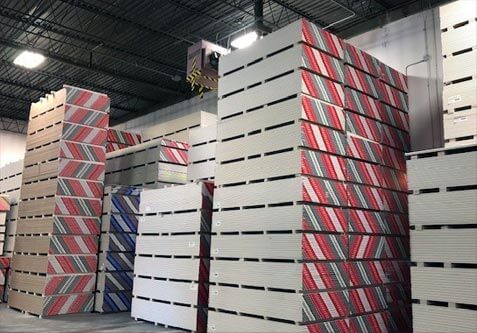
Fig2: Soundproof Drywall
Courtesy: fbmsales.com
While all drywall helps to dampen noise to some degree, soundproof drywall takes things further by including extra wood fiber, gypsum, and polymers to achieve a higher Sound Transmission Class (STC). An STC rating indicates how much sound a given material can dampen, much how the Richter scale rates earthquake destruction. Soundproof drywall is installed when more isolation is needed, such as between rooms or along common walls. It is more difficult to deal with since it is denser than regular drywall.
3. Green Board Drywall:
Drywall made from green boards is impervious to water damage. Because of the waterproof barrier coating, these are more expensive than standard drywall, but they’re ideal for high-moisture areas like bathrooms, kitchens, and basements. In addition to being a tile backer, it is commonly used in wet spaces, including bathrooms, basements, kitchens, laundries, and utility rooms.
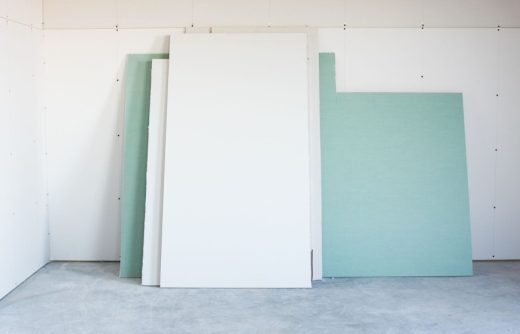
Fig3: Green Board Drywall
Courtesy: thespruce.com
4. Blue Board Drywall:
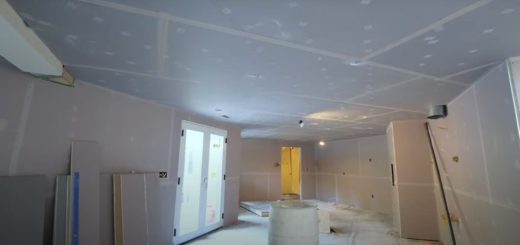
Fig4: Blue Board Drywall
Courtesy: specifier.com.au
Blue board, also known as Plasterboard, is used as a substrate for plaster applications, much like the lath in lath and plaster walls. Plasterboard requires a thin coat or plaster coatings to be put over the entire surface. The face paper is absorbent, allowing the plaster finish layer to attach to the drywall better. It’s utilized in older homes to provide the look of lath and plaster.
5. Purple Drywall:
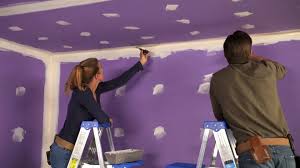
Fig5: Purple Drywall
Courtesy: constructioninstruction.com
Purple drywall is very resistant to moisture, mold, and mildew. It is also resistant to scuffs, dents, and scratches, so it will last longer and need fewer repairs. It can be used in bathrooms, laundry rooms, garages, and other areas that might get wet from rain or other water sources.
6. Fire-Resistant Drywall:
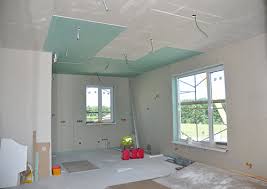
Fig6: Fire-Resistant Drywall
Courtesy: bernardibuildingsupply.com
Garages and basements sometimes have fire-resistant drywall installed to prevent fires from occurring around potentially combustible machinery. It’s not as explosive as conventional gypsum because it contains fiberglass, which acts as a firebreak. You can find Type X and Type C drywall, both fireproof. Type X is 5/8″ thick and provides up to an hour of fire protection. If further security is required, it might be applied in many layers. In every way, Type C is identical to Type X, except that it does not contract when heated. Its main purpose is to prevent ceilings from falling in the event of a fire.
7. Paperless Drywall:
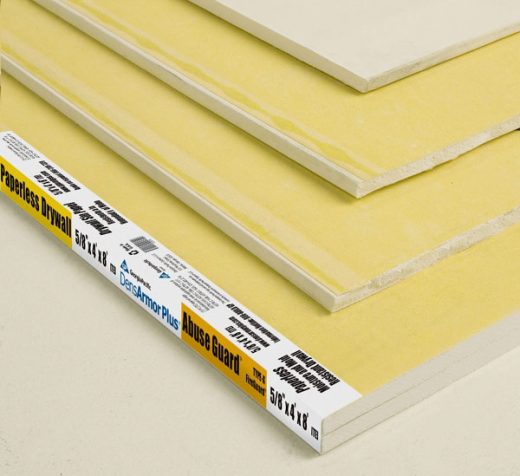
Fig6: Paperless Drywall
Courtesy: nachi.org
The gypsum core in paperless drywall is the same as in regular drywall. The main distinction is that fiberglass is used instead of paper for exterior pacing. Also, unlike the core of traditional drywall, the gypsum in paperless drywall is resistant to water damage. Installing paperless drywall is a good idea in any place where water or moisture might be present, including bathrooms, kitchens, basements, and garages.
Advantages of Drywall:
- Drywall can be put up faster, which affects how much energy is used while the building is being built.
- It doesn’t weigh much, so putting it together is quick and easy. It also takes less work to do.
- It cuts down on loads, which saves steel.
- Water is not needed for installation, so the site stays clean and tidy.
- It also saves time because it is easy and quick to set up. It also saves money on interest costs.
- It doesn’t catch fire because gypsum has crystalline water molecules, which stop the fire from spreading.
- It is easy to set up and will last for a long time, so it is a good value.
- It can build walls, ceilings, and a wall between two rooms. It is easy to take off and put back on and can be cut to any size. It means that you can fix a hole in the wall by cutting a piece of drywall to fit over the hole.
- You get smooth, flat surfaces that are perfectly straight and level, which is hard to do with regular plaster on a brick wall.
- When your ceilings and walls are made of drywall, it’s easy to put in recessed lighting and hang anything else you want.
- It doesn’t have the normal shrinking and cracking in brick or stone walls with cement plaster.
Disadvantages of Drywall:
- Drywall is not water-resistant; it can soak up water, which can then pass through it and sink. So, drywall ceilings can’t stop water from getting through them. Also, mold can grow on drywall that is too wet. We can even make drywall water-resistant if we use fiberglass instead of paper.
- If the drywall is not plastered, it is more likely to get damaged on the surface.
- The people working with drywall must be dedicated because the finish needs to be done better, and the joints need to be put together correctly so the drywall will be strong.
- Drywall installation makes a lot of dust, so the room should be clean before the work begins. If you don’t, the dust will get everywhere in the house.
Conclusion:
Drywall is an effective, lightweight partition system made from a GI steel frame covered in gypsum plasterboards on both sides and fastened with self-drilling drywall screws. After the joints have been taped, the gypsum jointing compound is used to complete the job. Drywall is widely utilized for its many advantages, including its ease of installation, portability, durability, versatility, dry construction, flexibility, great performance, environmental friendliness, etc.
References:
1. Steffen, John. “What Is Drywall | Types of Bathroom Drywall | Drywall Installation Process | Pros and Cons of Drywall Installation – ConstructUpdate.com.” ConstructUpdate.com, 17 June 2022, www.constructupdate.com/what-is-drywall-and-bathroom-drywall-types.
2. “6 Types of Drywall and How They’re Used – MT Copeland.” MT Copeland, 15 Oct. 2021, mtcopeland.com/blog/6-types-of-drywall-and-how-theyre-used.
3. RobeyInc. “Different Types of Drywall, Their Applications and Uses.” Robey, Inc. |, 22 Jan. 2019, robeyinc.com/different-types-of-drywall-applications-uses.
4. “Drywall System – Types and Benefits – Constro Facilitator.” Constro Facilitator, 30 Nov. 2020, constrofacilitator.com/drywall-system-types-and-benefits.
5. “How to Choose the Right Type of Drywall.” The Spruce, 2 Aug. 2022, www.thespruce.com/types-of-drywall-845079.
6. “What Is Drywall and What Is It Made Of?” Angi, 15 June 2021, www.angi.com/articles/what-is-drywall-made-of.htm
If you have a query, you can ask a question here.


